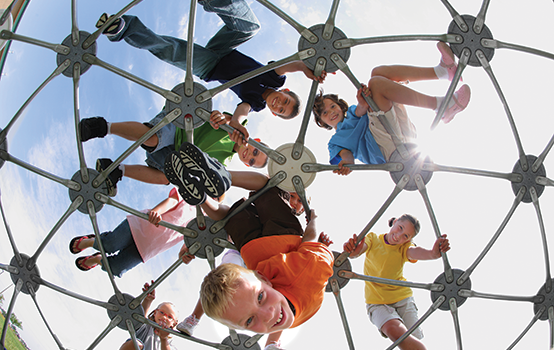 Learning is not just a cognitive function. Thinking, feeling, and physicality all come together to develop new knowledge and skills.
Learning is not just a cognitive function. Thinking, feeling, and physicality all come together to develop new knowledge and skills.
Active play and regular physical activity have a positive effect on student achievement, cognitive skills, and classroom behavior, according to a variety of studies. How does this knowledge square with expectations in the Common Core State Standards that educators will emphasize higher-order thinking and problem solving? Achieving these standards will create greater cognitive demands on students at all levels. Can we achieve that and still give children opportunities for play and physical activity at school?
Neuroscience research suggests that we can because exercise powers up brain areas associated with executive functions that support higher-order thinking and with learning and memory. In tandem, these lines of inquiry suggest how school schedules and lessons can be structured to optimize the effect of physical activity on students’ brain power.
Establishing the connection
Learning is not just a cognitive function. We use the term body-brain system to convey how the interactions of thinking, feeling, and physicality can enhance the development of new knowledge and skills (Wilson & Conyers, 2013a). A 2010 report from the Centers for Disease Control and Prevention summarizing 50 studies involving physical education, active play during recess, physical activity breaks in the classroom, and after-school sports and other activities found positive associations with academic performance. At the same time, this meta-analysis found no negative consequences for making physical activity a regular part of the school day, which should alleviate concerns that taking time away from core subjects for “play” might decrease grades and test scores.
Individually, these studies provide useful evidence on the relationship between an active body and improved cognitive abilities. A University of Illinois study reports that 9- and 10-year-olds performed better on reading comprehension, spelling, and math tests when they had 20 minutes of physical activity immediately before testing (CSBA & California Project LEAN, 2010). Another study found that more physically fit 5th, 7th, and 9th graders performed better than their less fit peers in math and, to a lesser degree, reading. Moderate to vigorous physical activity that increases the heart rate seems to have the greatest positive effect on academic performance.
North Carolina researchers compared the on-task learning behaviors of students immediately after 10-minute breaks involving physical activity and more sedentary breaks; students were more focused on learning after breaks that involved physical activity. Yet another study found that modes of transportation to and from school influence academic performance; “active transportation” such as walking, biking, and skateboarding improves cardiovascular fitness and “primes the brain for learning” (CSBA & California Project LEAN, 2010).
Active physical play gives young children opportunities to improve their interpersonal and motor skills and to enhance their attention to learning tasks.
Researchers have studied the effect of physical activity on the cognitive performance of children and youth across their years in school, from preschool through college. Active physical play provides opportunities for young children to improve their interpersonal and motor skills and to enhance their attention to learning tasks; it may also ease transitions between learning activities (Wilson & Conyers, 2013b). For example, kindergarten teacher Christena Nelson adapted the song “Off We Go (into the Wild Blue Yonder)” into a theme song and movement activity to transition into phonics lessons. “Off we go, to think about thinking,” the kindergartners sing as they engage in a brief workout to get ready for their lessons on letter sounds. “Off we go, to wake up our brain!”
At the college level, Irish researchers tested students’ recall on a memory test before and after a strenuous stationary bike ride. Students performed much better on the test after the workout and in comparison to a control group (Reynolds, 2011).
With a focus on college- and career-readiness, the Common Core State Standards aim to equip students with knowledge and skills that will help them thrive throughout their lives. A longitudinal study of a database on 1.2 million Swedish men who entered military service between 1950 and 1976 underscores how the combination of a healthy brain and body in the early years and beyond supports that goal. Analysis of the data, which included measurements of cardiovascular fitness, muscle strength, IQ, and cognitive abilities when the subjects were in their mid to late teens, found that cardiovascular fitness was associated with higher IQ and higher scores on cognitive assessments — and later in life with higher levels of education, socioeconomic status, and reported life satisfaction and lower risk of early-onset dementia (Nyberg et al., 2014). Individuals with a combination of low cardiovascular fitness and low cognitive performance in their teens had the greatest risk for dementia and milder forms of cognitive impairment later in life.
“But there is an even more intriguing pattern in the Swedish case,” note authors John Ratey and Richard Manning in their book Go Wild: Free Your Body and Mind from the Afflictions of Civilization (2014). “The data set included 270,000 brothers and 1,300 identical twins and showed that cardio fitness and not familial relationship turned out to be the better predictor of both cognitive ability and IQ. That is, despite the popular assumption that IQ is genetically determined, fitness and not genes held the greater sway over these tests of intellect” (p. 109).
How physical activity enhances brainpower
Exercise has been shown to enhance both neurogenesis (the creation of new brain cells in regions of the brain associated with higher-order thinking and recall) and experience-dependent synaptogenesis (the formation of synaptic connections between neurons in response to learning and sensory input from the environment). Specifically, physical activity appears to stimulate the production of a protein called brain-derived neurotrophic factor (BDNF), which helps neurons and synapses grow. In fact, BDNF has been likened to fertilizer for the brain (Ratey, 2008; Fotuhi, 2013).
Angiogenesis (the creation and maintenance of healthy blood vessels) is another mechanism by which exercise supports increased blood and oxygen flow to enhance brain functioning. As Fotuhi explains, “A healthy vascular network with dense branches of blood vessels means more nourishment for neurons, helping them to stay vibrant and alive, and better retention of the brain’s highways, allowing different parts of the brain to communicate more efficiently” (2013, p. 69).
Moderate to vigorous physical activity that increases the heart rate seems to have the greatest positive effect on academic performance.
Brain-imaging studies pinpoint specific areas of the brain involved in higher-order cognitive functions and memory that are activated and enhanced by physical activity. Employing functional magnetic resonance imaging, researchers compared the brain activity of children involved in cognitive control tasks. Subjects with higher levels of fitness showed “a superior ability to activate frontal and parietal brain regions important for the monitoring, maintenance, and strategizing of higher-level cognitive control abilities, important skills for academic performance” (Chaddock et al., 2012, p. 266).
In separate research by several members of the same team, two dozen 8- and 9-year-old children were enrolled in a nine-month, after-school program incorporating an average of 77 minutes of daily moderate to vigorous physical activity. Based on tests of cognitive performance and brain scans before the program began and at its conclusion, the children demonstrated improved performance on the tests, and the scans indicated more efficient functioning in the prefrontal cortex. This region is known as the “CEO of the brain” for its role in managing executive functions and higher-order thinking.
In another study, researchers measured the oxygen consumption levels, a common assessment of fitness, of 9- and 10-year-olds after they worked out on a treadmill and then conducted fMRI brain scans. Subjects with higher levels of physical fitness had hippocampi that were 12% larger relative to total brain size than their less fit peers (Fotuhi, 2013). The hippocampus is “the gateway for new memories and essential for learning” (Fotuhi, 2013, p. 16).
Positive emotions
This research demonstrates the direct connection between a healthy body and peak brain functioning. Another component that contributes to a fully optimized body-brain system is emotional outlook. A positive learning environment is more conducive to learning than an atmosphere characterized by stress and negativity. When students are optimistic about their ability to master a difficult learning challenge, they’re more likely to persist and put in the sometimes hard work required to achieve success (Boman et al., 2009). They may need to overcome setbacks and disappointments along the way, but an optimistic mindset can help surmount those difficulties. Physical activity is known to boost mood and support a positive outlook that is conducive to learning gains.
Physical activity is known to boost mood and support a positive outlook that is conducive to learning gains.
Positive mood induced by exercise is related to the release of neurochemicals such as endorphins, melatonin, and serotonin, which increase neural activation in parts of the brain associated with positive emotions and increased attention and focus (Hecht, 2013). This near-instantaneous effect of exercise in boosting mood has been shown to alleviate depression and anxiety (Weir, 2011); it is a natural antidote to unhealthy stress that can impair learning. The relationship between physical activity and optimism may convey several benefits that extend to facilitating academic performance: Students experience a boost in mood after exercising, and their feelings of self-efficacy and mastery in completing the physical activity further reinforce a positive, can-do attitude. In short, regular exercise boosts both cognitive functioning and an optimistic outlook, completing a positive feedback loop that supports learning.
Putting the research to work
These findings from school and neuroscientific research suggest several strategies teachers, administrators, and policy makers can wield to optimize learning for students of all ages:
- Get students moving. Explore ways to get students to move as they travel to and from school, at recess, during physical education, and during and between lessons. Incorporating movement into lessons and planning active games to reinforce lesson content have the added benefit of making learning fun, engaging, and memorable. “The importance of regular physical activity to the developing body and mind cannot be overstated” (Best, 2010, p. 351).
- Look for creative ways to incorporate exercise into learning activities. For example, Kelly Rose, an instructional media specialist at a Florida primary school, employs “brains breaks” as a way to incorporate movement into library activities. She also shared how physical activity supports learning in a school assembly with a dance video that got her entire school moving. Georgia middle school teacher Maureen Ryan teaches physical education and keeps a stationary bike in her health classroom as well, so students can take turns pedaling and reading without disrupting the instructional flow. That strategy engages students who have a hard time just sitting at their desks. When students in a literacy class at Naperville (Ill.) High School were reading about a character on a long bike ride, their teachers brought exercise bikes into the classroom so students could chart their mileage while pedaling and experiencing some of the same physical effects as the character in the story (Robert Wood Johnson Foundation, 2012).
- Schedule physical activity when it matters most. Several of the studies cited here found benefits of engaging in physical activity directly before taking tests or especially challenging classes. In an experiment at Naperville High School, students taking a physical education class, appropriately titled “Learning Readiness P.E.,” right before a literacy class showed twice as much improvement in their literacy skills as students who had several hours between physical education and the literacy course.
- Involve the whole family. By sharing the research on the strong connection between learning success and exercise, teachers can encourage parents and other family members to incorporate physical activity into family time in the evenings, on the weekends, and through the summer months.
- Establish a school health advisory council or wellness committee. Include school staff, parents, students, and other community members on the committee, and have them meet regularly to develop and implement plans for incorporating physical activity throughout the school day.
- Guide students to internalize the role of exercise in learning success. Understanding that physical activity makes their brains function more effectively and efficiently gives students one more reason to make exercise a lifelong habit that will serve them well in school, in their personal lives, and in their future careers.
The Common Core and other standards require higher levels of cognitive activity and, in turn, aim to increase cognitive performance. Providing regular opportunities throughout the school day to enhance students’ cardiovascular fitness could truly set them up for college- and career-readiness and greater cognitive, physical, and emotional health.
References
Best, J.R. (2010, December). Effects of physical activity on children’s executive function: Contributions of experimental research on aerobic exercise. Developmental Review, 30 (4), 331-351. www.ncbi.nlm.nih.gov/pmc/articles/PMC3147174/
Boman, P., Furlong, M.J., Shochet, I., Lilles, E., & Jones, C. (2009). Optimism and the school context. In R. Gilman, E.S. Huebner, & M.J. Furlong (Eds.), Handbook of positive psychology in school (pp. 51-64). New York, NY: Routledge.
California School Boards Association (CSBA) & California Project LEAN. (2010). Active bodies, active minds: Physical activity and academic achievement [Fact sheet]. www.californiaprojectlean.org/docuserfiles/AcademicAchievement_FactSheet_WEB_final.pdf
Centers for Disease Control and Prevention. (2010, April). The association between school-based physical activity, including physical education, and academic performance. www.cdc.gov/healthyyouth/health_and_academics/pdf/pa-pe_paper.pdf
Chaddock, L., Erickson, K.I., Prakash, R.S., Voss, M.W., VanPatter, M., Pontifex, M.B., Hillman, C.H., & Kramer, A.F. (2012). A functional MRI investigation of the association between childhood aerobic fitness and neurocognitive control. Biological Psychology, 89, 260-268.
Fotuhi, M. (2013). Boost your brain: The new art and science behind enhanced brain performance. New York, NY: HarperOne.
Hecht, D. (2013, September). The neural basis of optimism and pessimism. Experimental Neurobiology, 22 (3), 173-199.
Nyberg, J., Aberg, M.A.I., Schioler, L., Nilsson, M., Wallin, A., Toren, K., & Kuhn, H.G. (2014). Cardiovascular and cognitive fitness at age 18 and risk of early-onset dementia. Brain, A Journal of Neurology, 2014 (137), 1514-1523.
Ratey, J.J. (2008). Spark: The revolutionary new science of exercise and the brain. New York, NY: Little, Brown.
Ratey, J.J. & Manning, R. (2014). Go wild: Free your body and mind from the afflictions of civilization [Kindle edition]. New York, NY: Little, Brown.
Reynolds, G. (2011, November 30). How exercise benefits the brain. The New York Times. well.blogs.nytimes.com/2011/11/30/how-exercise-benefits-the-brain/?_r=0
Robert Wood Johnson Foundation Center to Prevent Childhood Obesity. (2012). Naperville High School [Case study]. www.rwjf.org/content/dam/farm/reports/reports/2012/rwjf72720
Weir, K. (2011, December). The exercise effect. Monitor on Psychology, 42 (11). www.apa.org/monitor/2011/12/exercise.aspx
Wilson, D.L. & Conyers, M.A. (2013a). Five big ideas for effective teaching: Connecting mind, brain, and education research to classroom practice. New York, NY: Teachers College Press.
Wilson, D.L. & Conyers, M.A. (2013b). Flourishing in the first five years: Connecting implications from mind, brain, and education research to the development of young children. Lanham, MD: Rowman & Littlefield.
CITATION: Conyers, M. & Wilson, D. (2015). Smart moves: Powering up the brain with physical activity. Phi Delta Kappan, 96 (8), 38-42.
ABOUT THE AUTHORS

Donna Wilson
DONNA WILSON is coauthor of Five Big Ideas for Effective Teaching: Connecting Mind, Brain, and Education Research to Classroom Practice and Positively Smarter: Science and Strategies for Increasing Happiness, Achievement, and Well-Being .

Marcus Conyers
MARCUS CONYERS is coauthor of Five Big Ideas for Effective Teaching: Connecting Mind, Brain, and Education Research to Classroom Practice and Positively Smarter: Science and Strategies for Increasing Happiness, Achievement, and Well-Being .










